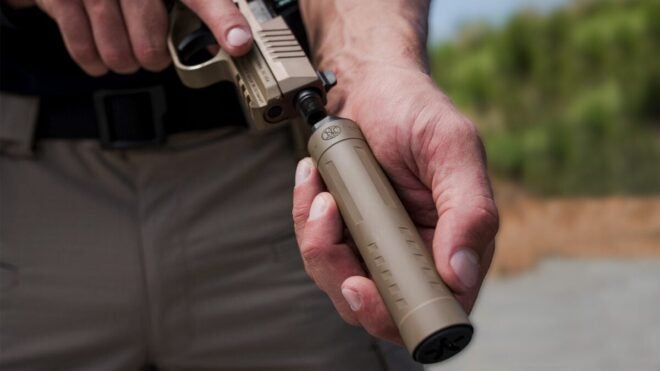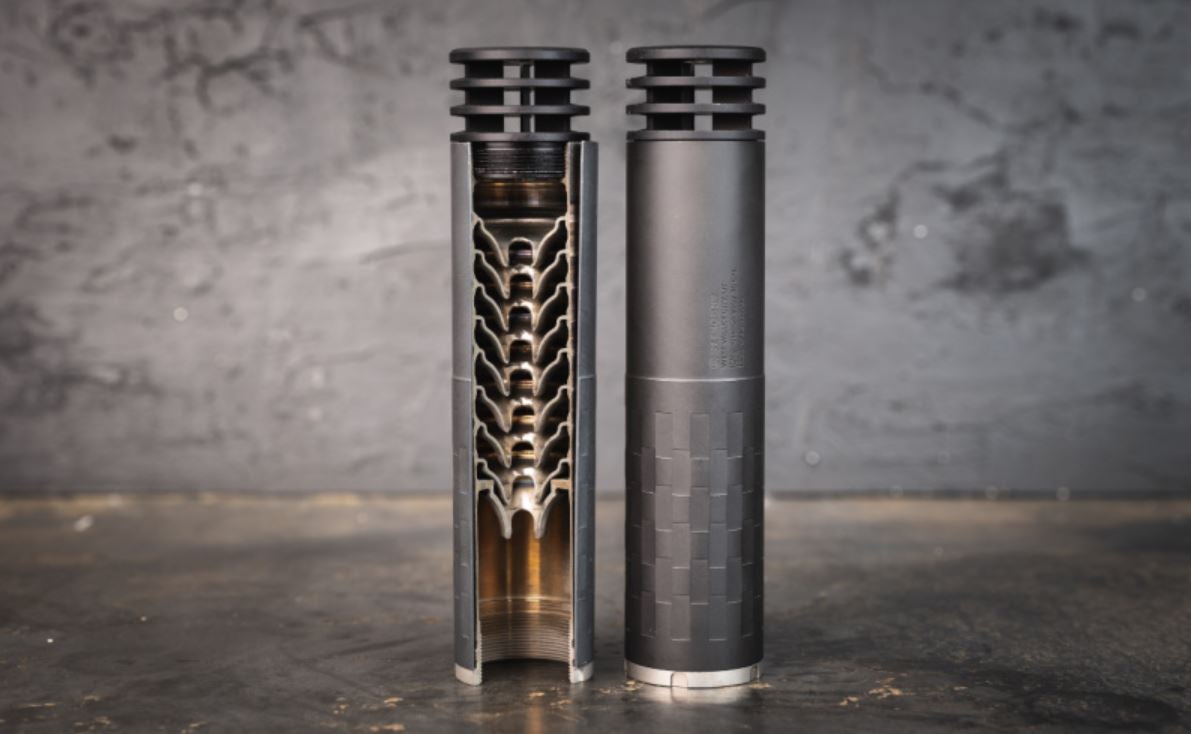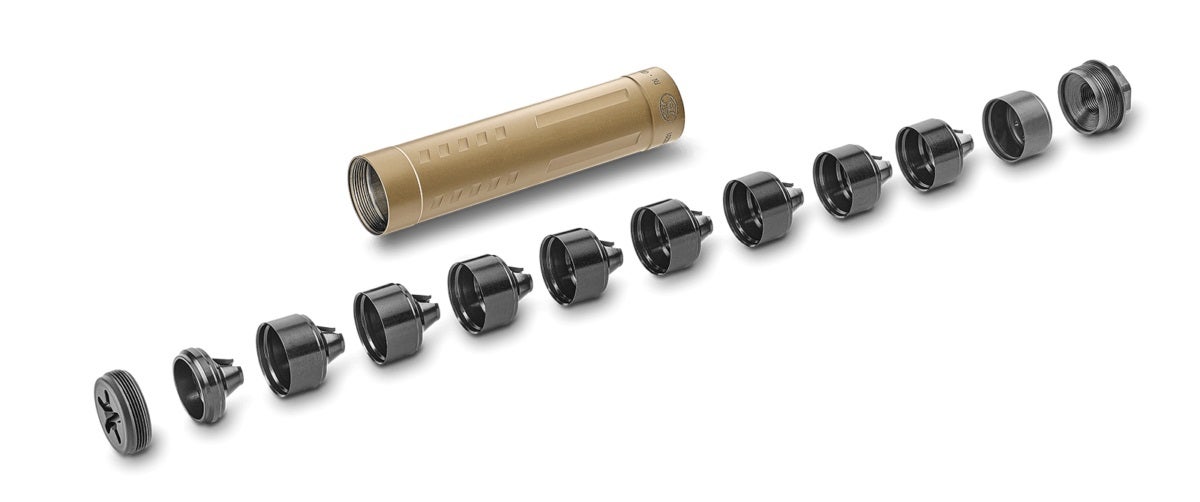The Beginner’s Guide to Suppressors – How Do They Work & Function?
Travis Olander 11.06.23

You’ve seen ’em in war films and so many James Bond flicks. The suppressor, silencer, muzzle muffler, whisper can – it has many nicknames – is one of the best investments you can make in the shooting hobby. Suppressors can significantly reduce any firearm’s audible shot report, reducing the risk of hearing damage and even making some firearms hearing-safe with little to no hearing protection. Chances are, you’re not wearing ear pro when you’re hunting. But it is, indeed, legal to hunt with a suppressor in many states – yet another reason to buy a can for your favorite rifle.
Silencer Coverage on AllOutdoor
- SilencerCo’s 15-Year Triumph: The Revamped Sparrow-Ti
- Home on the Range #055: Daniel Defense Soundguard SG-30Ti Silencer
- S&W Grand Opening, Silencer Central at Gemtech Booth & ABYSS 7.62
- Silencer Central Releases the BUCK 30 by BANISH with Buck Commander
But owning a suppressor requires filing a bunch of paperwork with the ATF and, because they’re so heavily restricted, they’re expensive to manufacture and purchase. Lots of gun owners simply don’t bother with jumping through the hoops, which leaves suppressors relegated to the niche “NFA” category of gun ownership. That means you’ve probably got a few questions about suppressor. Here’s your beginner guide. Let’s start with some of the most common questions:
What, Exactly, are Suppressors?
Let’s start with the ATF’s official definition:
The term “Firearm Silencer” or “Firearm Muffler” means any device for silencing, muffling, or diminishing the report of a portable firearm, including any combination of parts, designed or redesigned, and intended for the use in assembling or fabricating a firearm silencer or firearm muffler, any part intended only for use in such assembly or fabrication.
So, a suppressor, or silencer, can be any muzzle device which reduces the audible sound of gunfire by any degree. The terms “suppressor” and “silencer” are completely interchangeable – they are one and the same. Importantly, because the ATF likes to label individual gun parts as complete firearms, any one part of a suppressor – like a baffle – can be considered a suppressor under federal law.
Are Suppressors considered a Firearm?
Yes. Suppressors fall under the “NFA” category if firearms, which means they’re legally no different than any short-barreled rifle, short-barreled shotgun, and similar firearms regulated by the National Firearms Act of 1934. Because suppressors are NFA items, there are some extra requirements you need to meet to legally own one:
- You must be 21 years of age or older
- You must pay a $200 tax to own one
- You must pass an “enhanced” background check
- You must live in a state that hasn’t banned suppressors
At publication, eight states fall under that last category: California, Delaware, Hawaii, Illinois, Massachusetts, New Jersey, New York, and Rhode Island. Remember that state gun laws change constantly, so it’s always a good idea to check your local and state laws before trying to purchase or possess any type of firearms.
How do Suppressors Work?
Pictured: Omega 300, available at Silencer Co
No matter the maker, nor its shape or appearance, every modern firearm suppressor functions using the same principle: Gas exiting the muzzle of the firearm is direct into the suppressor, where its speed, flow, and energy are interrupted and reduced by a series of chambers.
By the time the gas exits the end of the suppressor, its energy – and, therefore, its sound – has been sufficiently reduced. Most of this energy is converted into heat, which is why suppressors are so expensive: They’re often made of exotic alloys that are difficult to make and machine, which includes certain stainless steels, titanium, cobalt, and Inconel, a nickel-chrome “superalloy”.
Although this concept is simple, designing the chambers in a suppressor to reduce sound energy as much as possible – and without the suppressor overheating or failing – is a long, complex, and scientific process involving the study of thermodynamics and fluid dynamics.
How much do Suppressors reduce Sound?
The most effective suppressors can reduce the sound energy of gunfire by up to 30 to 32 decibels (dB). A decent suppressor should afford at least 22 to 25 dB of noise reduction. Many suppressors are designed for specific calibers and loads, providing the most sound reduction possible.
The Omega 300 shown above can reduce the volume of subsonic 300 Blackout rounds to just 119 dB. That’s quiet enough to fire intermittently indoors without wearing any hearing protection. In reality, no firearm suppressor will ever sound like the silencers in Hollywood films – but any can capable of getting your firearm’s muzzle blast below 120 dB is considered top-tier.
For context, only subsonic and rimfire ammo is capable of being made this quiet. Most supersonic rounds will never fall below 130 dB. Suppressors aren’t capable of eliminating the audible shock wave produced by supersonic ammo downrange. In this case, ear pro is still required to prevent hearing damage.
Types of Suppressors
The chambers in a suppressor are formed into two possible configurations: A monocore baffle, which uses a single piece of alloy, machined with various holes and curvatures, or a series of individual baffles that stack atop one another (as exampled above, in the cutaway of an Omega 300 suppressor).
Monocores
Compared to baffled setups, monocores (like this core for the Kinetic Suppressor MOJO-22 from Quentin Defense) provide some distinct advantages: They’re physically stronger, and can withstand heat and higher rounds count before fatiguing or failing. They’re also easier to disassemble and clean, as the baffled core is removed as one piece.
Monocores suffer some drawbacks, though: They’re often heavier than baffled cans, and they may not provide as much sound reduction. If, for some reason, your monocore suffers a baffle strike, it cannot be fixed – the entire assembly needs to be replaced.
Baffles
Most suppressors on the market today use baffles. They’re simply superior to monolithic setups when it comes to sound reduction, size, and weight. Baffles can be customized and finely tuned for specific calibers and loads, too – like these baffles inside the FN Catch 22 Ti. With a baffled system, you can reconfigure your can and optimize its performance for all the calibers you shoot. Individual baffles can be easily replaced, too – as is often required after a few thousand rounds are sent through your tube.
Modular Suppressors
Modular suppressors, like this 12-gauge can from JK Armament, are relatively new to the scene. They combine each individual baffle with a threaded, removable portion of the exterior shell of the suppressor itself. Modular suppressors allow for even easier reconfiguration – for extra suppressor, just add a section to the tube. To reduce size and weight for smaller, quieter loads, remove a few sections.
Suppressor Attachments
There are loads of suppressor attachment options – too many to cover in this guide. But that’s OK! We’ve got an entire guide to suppressor attachment types. The short n’ sweet version is that suppressors are attached by two methods: Direct thread, wherein one end of the suppressor threads onto the muzzle, like any other muzzle device, and quick-detach, or “QD”. QD attachments can use smaller, tapered threads or spring-loaded mechanisms that make removal quicker and easier, without requiring any tools. Learn more about JK Armament’s modular cans: James Reeves visited with Silencer Shop at SHOT 2023 to get his hands on their 12-gauge suppressor.



